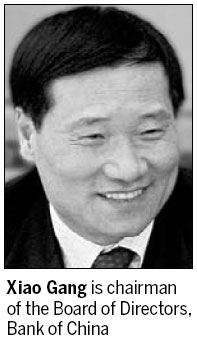
Internationalization of China's currency is inevitable and it should prepare for the systematic financial risks that will arise
Just a few years ago, it would have been difficult to imagine that the global use of the renminbi would spread so fast. However, today we can see the situation has changed greatly.
In 2011, China and its trade partners conducted cross-border renminbi trade settlements valued at 2.58 trillion yuan ($410 billion), more than 4 times the 2010 total, and covering nearly 10 percent of the China's total trade.
Meanwhile, renminbi-denominated overseas and foreign direct investment - a pilot program which began in 2011 - reached 110 billion yuan. So far, China's central bank has signed bilateral currency swap agreements valued at 1.6 trillion yuan with 16 of its counterparts around the world.
Although status as a major global reserve currency is closely associated with full capital account convertibility, a flexible currency regime, deep and liquid capital markets and a willingness to let other countries accumulate the currency, through running trade deficits, it should be remembered that the renminbi still has many opportunities to internationalize further before these conditions are met. In fact, the currency's ascendancy and progress toward these conditions can occur simultaneously.
Historically, the internationalization of a sovereign currency is determined by the size of its economy and trade. The United States' economy surpassed the United Kingdom's around the time of the World War I, and the latter lost its status as the world's largest exporter in the 1920s. Finally, the US dollar displaced Sterling as the major global reserve currency around World War II.
As the world's second largest economy, the largest exporter and the second largest importer, China has become increasingly integrated into the world economy, and this has been one of the main driving forces toward the renminbi's global usage. Moreover, China is one of the largest destinations for foreign direct investment, $1.22 trillion from 1978 to 2011.
A fully convertible currency does not equal an international reserve currency. Nowadays, around 100 countries maintain fully convertible currencies, but only a few are used as global reserves. That is to say, the internationalization of a currency can proceed before its capital account is liberalized. It was under such conditions of inconvertibility that the German and Japanese currencies internationalized. A current account surplus should not be a barrier to the path of forging an international currency. The UK, the US, Germany and Japan all internationalized their currencies whilst running trade surpluses. The most important channel for currency outflow was overseas capital investment, in particular, letting credit follow trade outside the countries and have a capital account deficit.
Despite its overall long-term net trade surplus, China runs bilateral deficits with many Asian countries, therefore, there is large potential for wider use of the renminbi. On the other hand, as more and more Chinese enterprises go abroad, China has accelerated its overseas direct investment, totaling $437.3 billion in 178 countries and regions by the end of 2011. The International Monetary Fund forecasts that China's yearly ODI will exceed $280 billion by 2016.